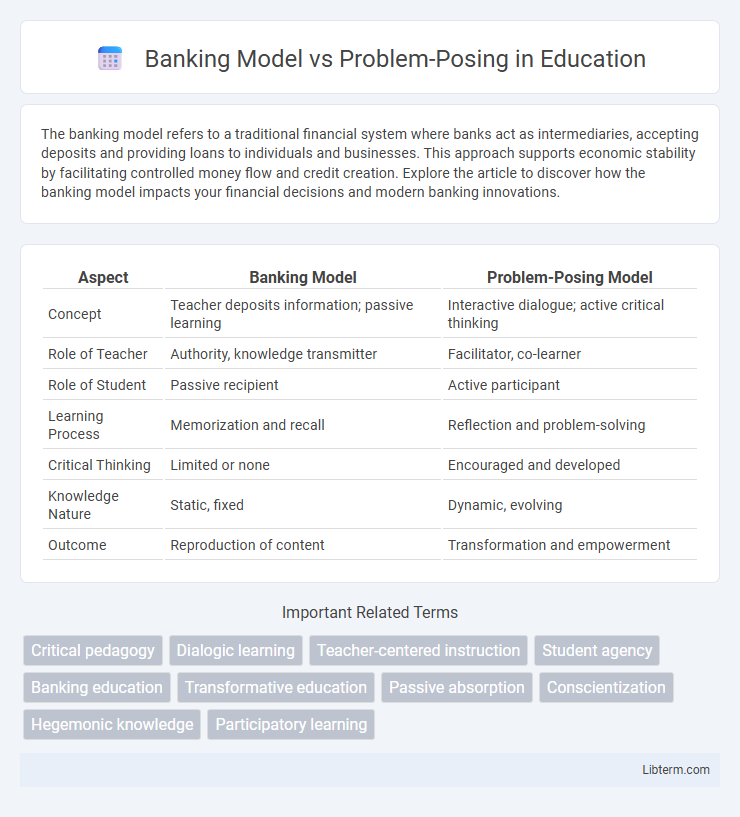The banking model refers to a traditional financial system where banks act as intermediaries, accepting deposits and providing loans to individuals and businesses. This approach supports economic stability by facilitating controlled money flow and credit creation. Explore the article to discover how the banking model impacts your financial decisions and modern banking innovations.
Table of Comparison
| Aspect | Banking Model | Problem-Posing Model |
|---|---|---|
| Concept | Teacher deposits information; passive learning | Interactive dialogue; active critical thinking |
| Role of Teacher | Authority, knowledge transmitter | Facilitator, co-learner |
| Role of Student | Passive recipient | Active participant |
| Learning Process | Memorization and recall | Reflection and problem-solving |
| Critical Thinking | Limited or none | Encouraged and developed |
| Knowledge Nature | Static, fixed | Dynamic, evolving |
| Outcome | Reproduction of content | Transformation and empowerment |
Introduction to Banking and Problem-Posing Models
The Banking Model of education treats students as passive recipients of knowledge, where teachers deposit information into learners much like a bank transaction. In contrast, the Problem-Posing Model encourages active dialogue and critical thinking, positioning students as co-creators of knowledge through questioning and reflection. This shift from memorization to interaction fosters deeper understanding and empowerment in the learning process.
Defining the Banking Model of Education
The Banking Model of Education conceptualizes students as passive recipients of knowledge where information is deposited by the teacher and stored by the learner without critical engagement. This model emphasizes rote memorization and repetition, limiting creativity and critical thinking skills. Paulo Freire criticized this method for maintaining oppressive structures by discouraging dialogue and reinforcing authoritarian teaching practices.
Key Characteristics of the Problem-Posing Model
The Problem-Posing Model emphasizes active dialogue and critical thinking, encouraging learners to engage collaboratively in knowledge construction rather than passively receiving information. It fosters reflective inquiry, where students question and analyze content, promoting deeper understanding and empowerment. This model supports a dynamic educational environment that values students' experiences and challenges traditional authoritarian teaching methods.
Historical Background and Paulo Freire’s Influence
The Banking Model of education, critiqued by Paulo Freire in his 1970 work *Pedagogy of the Oppressed*, originates from traditional, authoritarian teaching methods where students are passive recipients of information. Freire's Problem-Posing Model emerged as a radical alternative, emphasizing dialogue, critical thinking, and the co-creation of knowledge, influenced by his experiences with literacy campaigns in Brazil during the 1960s. His approach challenged the oppressive structures of the Banking Model by promoting education as a practice of freedom rooted in social justice and humanization.
Differences in Teacher and Student Roles
The Banking Model positions teachers as knowledge depositors who transmit information to passive students receiving and memorizing content without critical engagement. In contrast, the Problem-Posing Model transforms teachers into facilitators guiding students to actively question, reflect, and co-create knowledge through dialogue. This shift fosters a collaborative learning environment where students develop critical thinking skills and agency, rather than mere receptacles of information.
Impact on Critical Thinking and Creativity
The Banking Model of education limits critical thinking and creativity by encouraging passive memorization and the reproduction of information, which stifles student engagement and innovation. Conversely, Problem-Posing education promotes active dialogue, encouraging learners to question, analyze, and collaboratively solve problems, thereby enhancing their critical thinking skills and creative capacities. Research shows that students exposed to Problem-Posing methods demonstrate improved problem-solving abilities and greater intellectual independence compared to those subjected to the Banking Model.
Advantages and Critiques of the Banking Model
The Banking Model, characterized by passive knowledge deposit from teacher to student, offers structured learning and clear expectations that enhance standardized testing performance and curriculum coverage. However, critiques highlight its limitation in fostering critical thinking, creativity, and student engagement, often reducing learners to mere receptacles of information. This model's emphasis on memorization can undermine active learning approaches advocated in Problem-Posing education, which prioritize dialogue and critical consciousness.
Benefits and Challenges of Problem-Posing Education
Problem-Posing Education enhances critical thinking and active learning by encouraging students to engage with content through dialogue and reflection, fostering deeper understanding and creativity. This approach challenges the traditional Banking Model, which treats students as passive recipients of information, by promoting collaboration and the development of problem-solving skills. However, Problem-Posing Education requires skilled facilitators and may face resistance in standardized testing environments due to its less structured format.
Real-World Applications and Classroom Examples
The Banking Model of education treats students as passive recipients of knowledge, which limits critical thinking and real-world problem-solving skills. In contrast, the Problem-Posing model engages students actively by encouraging dialogue, fostering critical reflection, and applying concepts to real-world scenarios such as community projects or case studies. Classroom examples include collaborative group discussions and project-based learning that connect theoretical content to practical applications in finance, healthcare, and environmental studies.
Choosing the Right Model for Effective Learning
Selecting the appropriate educational approach between the Banking Model and Problem-Posing depends on the desired learning outcomes and learner engagement. The Banking Model, characterized by rote memorization and passive reception of information, limits critical thinking and creativity, while the Problem-Posing model fosters active dialogue, critical reflection, and deeper understanding. Effective learning is achieved by prioritizing Problem-Posing methods that encourage collaboration, inquiry, and empowerment, aligning with modern pedagogical goals for student-centered education.
Banking Model Infographic

 libterm.com
libterm.com